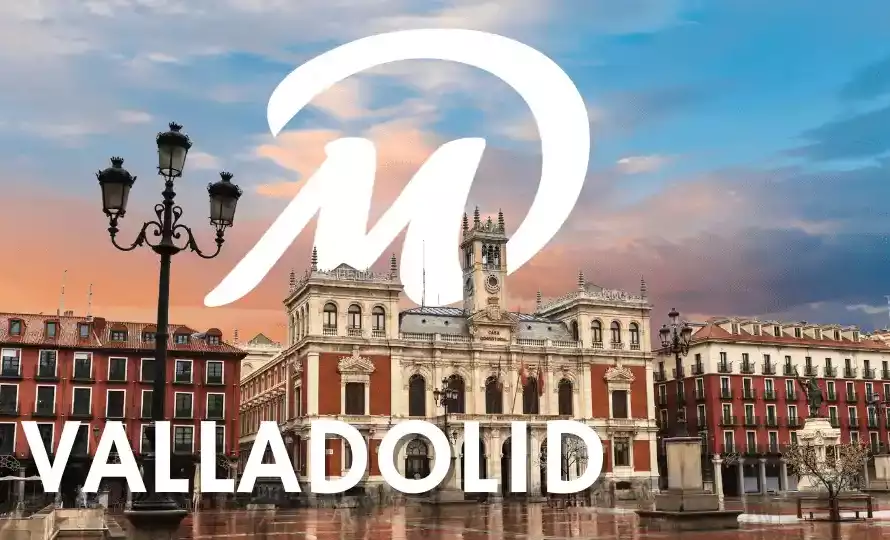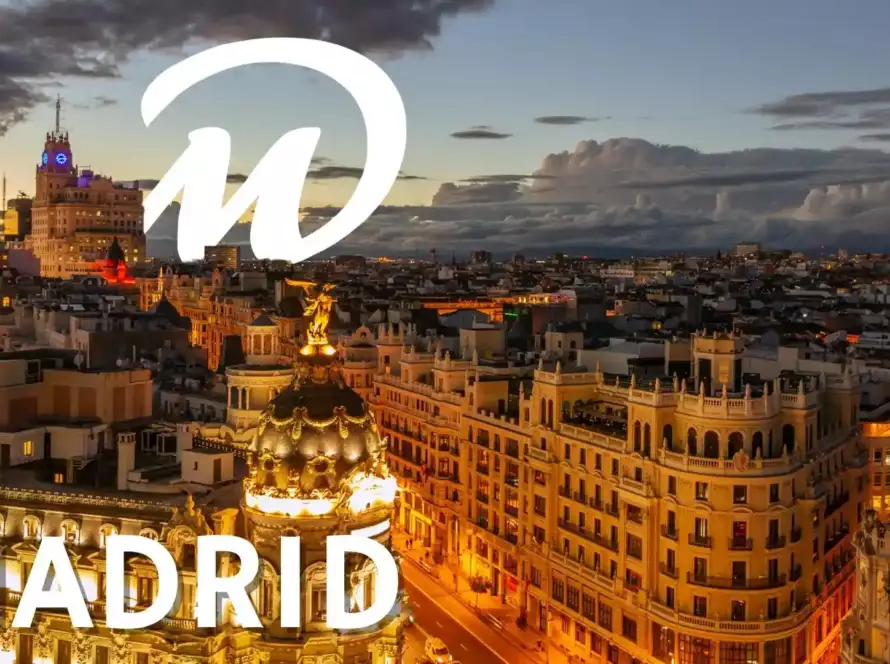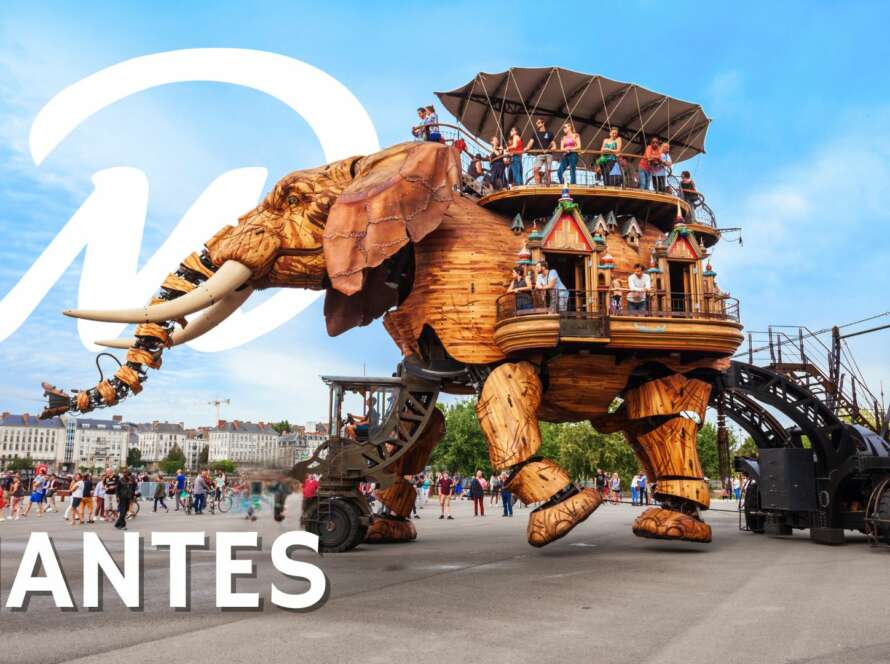Did you know that in Pula you can walk among Roman amphitheatres, ancient temples and fortresses overlooking the Adriatic? Here history mixes with everyday life: the Roman Amphitheatre takes you back to Roman times, the Temple of Augustus holds the secrets of emperors, and the Kastel offers breathtaking panoramic views.
If you are wondering about the things to do in Pula, in this guide you will discover the must-see places and plans that will make your visit unforgettable: from strolls through the historic centre and local markets to tasting the typical gastronomy in charming restaurants.
do you want to know where to try the most traditional dishes, which is the best viewpoint in the city or which nearby excursions are not to be missed? Here we not only tell you what to see in Pula, but also how to experience it authentically, at your own pace and with excitement.
DO YOU WANT TO KEEP SEARCHING THROUGH BLOGS OR WOULD YOU PREFER TO HAVE YOUR GUIDE TO PULA READY TO GO?
The DareMapp app makes it easy. Enjoy the COMPLETE GUIDE ON YOUR PHONE and experience every corner in a unique way. No timetables and at your own pace.
INDEX
- Things to do in Pula: 10 must-see places
- Roman Amphitheatre of Pula (Arena of Pula)
- Temple of Augustus
- Arch of the Sergii (Arch of Triumph)
- Gate of Hercules
- Kastel (Pula Castle)
- Roman Theatre
- Brijuni National Park
- Verudela Point
- Ambrela Beach
- Pula Central Market
- Other things to do in Pula
- Typical gastronomy of Pula: what to eat
- Museums to visit in Pula
- Alternative things to do in Pula
- Nearby excursions from Pula
- Local legends and curiosities of Pula
- Practical advice and top tips for travelling to Pula
Things to do in Pula: top 10 must-see places
If you’re looking for things to do in Pula, start by travelling back in time… about 2,000 years ago. In this southern Istrian town, every stone whispers tales of gladiators, emperors, and merchants who once filled its streets. Here are the 10 best places to experience the essence of Pula.
Roman Amphitheatre of Pula (Pula Arena)
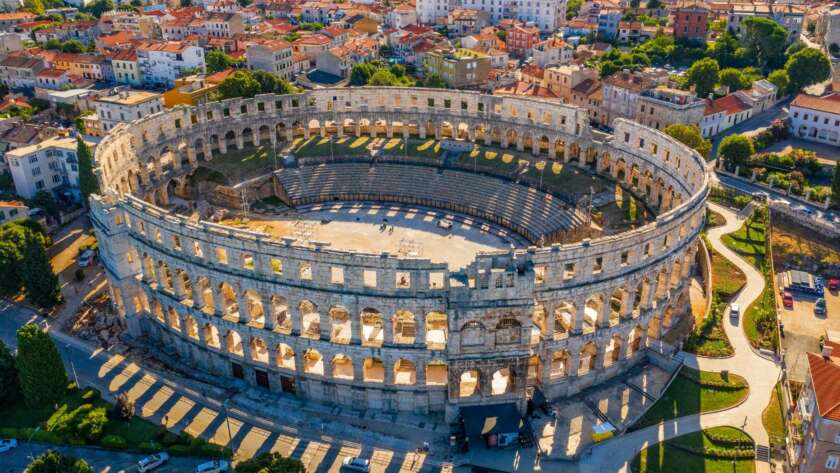
The Roman Amphitheatre of Pula was built in the 1st century AD under Vespasian. It is the historical heart of ancient Pietas Iulia, one of the most important cities of the Adriatic during the Roman Empire.
With a capacity for some 23,000 people, it was here that gladiatorial combats, public trials and spectacles were held to strengthen the power of Rome. Its location by the sea was no accident: the sloping terrain offered stability.
This is one of the six best-preserved amphitheatres in the world and the only one to retain its original external structure with its four towers intact. In its underground galleries you can still see the remains of the old oil presses and utensils that tell the story of daily life at the time.
During the Middle Ages, some of its stones were reused in other buildings, but in the 19th century the Austro-Hungarian government encouraged its restoration. Today it is once again full of people with concerts, operas and the Pula International Film Festival, one of the most important cultural events in Croatia.
👁 Discover the best things to do in Pula, a city on the Adriatic coast where its Roman past and timeless charm still shape every street.
Don’t miss it. With DareMapp, your new tourism app, your guide on your phone and without complications
Temple of Augustus

Among the places you can’t miss if you’re looking for things to do in Pula, the Temple of Augustus is a must-see. Standing on Forum Square, once the political and religious heart of the Roman city, this temple dedicated to Emperor Augustus has endured for more than two thousand years.
Built between 2 BC and 14 AD, it is one of the best preserved Roman temples outside Italy. Its Corinthian-style façade still displays the original columns and the sobriety characteristic of early Roman architecture. Sculptures and artefacts from the Imperial period found in the Istrian region are displayed inside.
The temple survived earthquakes, wars and centuries of urban transformation. In the Middle Ages it was used as a church and later as a grain store. In 1944 it was severely damaged by bombing, but its reconstruction restored the Forum to its classical appearance.
Arch of the Sergii (Arch of Triumph)
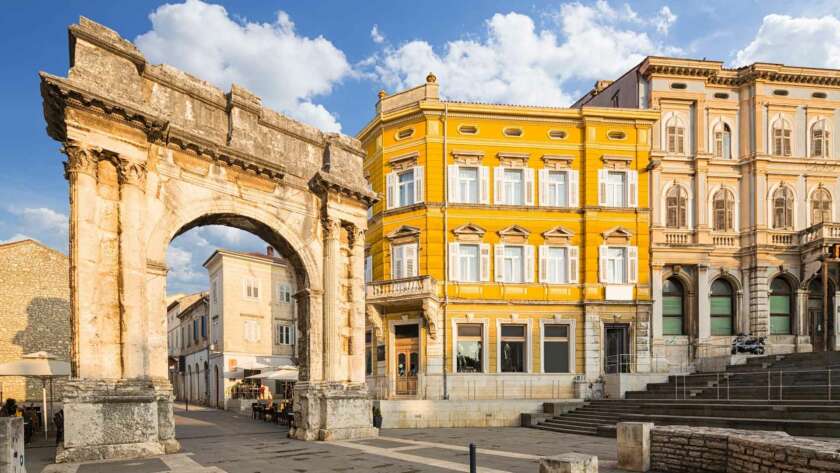
Among the most emblematic things to do in Pula, a visit to the Arch of the Sergii is a must. Built at the end of the 1st century BC, this triumphal arch was commissioned by Salvia Postuma to honour three members of her family — the Sergius brothers, who held high ranks in the Roman army.
Its function was both commemorative and symbolic: it marked the eastern entrance to the ancient Roman city, where the road leading to the port began. Carved in local limestone, the arch is remarkable for its Corinthian-inspired reliefs and decorative carvings which, though weathered by time, still reflect the artistic refinement of the period.
For centuries, the Arch of the Sergii was a meeting and reference point for the inhabitants of Pula.
Gate of Hercules
If you’re exploring the best things to do in Pula, the Gate of Hercules is a stop that takes you straight back to the city’s earliest Roman days. Built in the 1st century BC, it’s the oldest surviving entrance to Pula and owes its name to the carved figure of Hercules that once crowned its central arch.
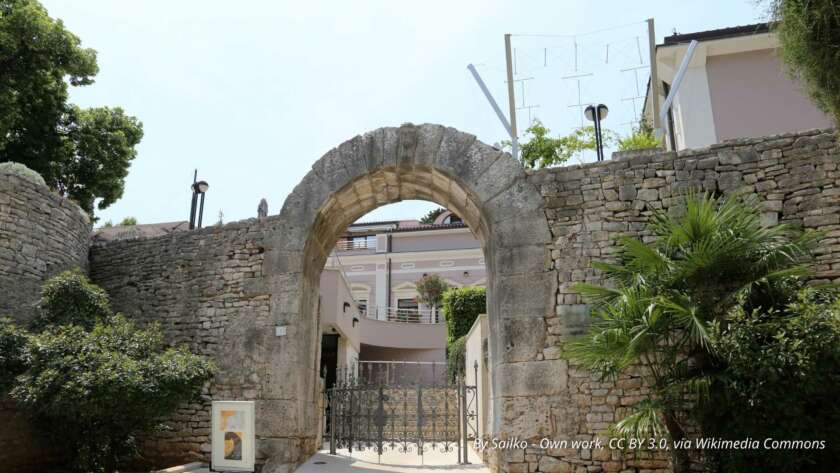
This gate was part of the city walls that protected the city and served as a symbol of the power and security of the Roman Empire in the region. Carved from local limestone, it retains decorative details that reflect late Roman architectural influence and a taste for heroic reliefs.
Over the centuries, the gate has seen the city evolve, welcoming merchants, soldiers and citizens through its arch — a true living symbol of Pula’s history. Today, in its pedestrian setting, you can take your time to admire its details, trace the lines of its ancient stonework, and understand how the Roman city once blended seamlessly into the daily rhythm of modern life — one of the most fascinating things to do in Pula.
Kastel (Pula Castle)

Among the most interesting things to do in Pula, a visit to the Kastel stands out for its blend of military history, medieval architecture, and sweeping views over the town and harbour. Built in the 17th century on the remains of earlier Roman and medieval fortifications, the Kastel was a key part of the defensive network that protected Pula from land and sea attacks, especially under Venetian rule.
The polygonal castle offers a unique experience: climbing its ramparts is a journey through centuries of history as you look out over the Adriatic, the harbour and the old town. Inside the castle there are exhibits showing the military evolution of Pula, as well as archaeological remains linking Roman and medieval times.
Beyond its defensive function, the Kastel is also a cultural symbol. Today it hosts concerts, cultural events and workshops, integrating itself into the life of the town without losing its historical essence. The visit allows you to understand how Pula has evolved, combining its Roman past with the Middle Ages and today’s urban life.
Traveller’s tip: climb up to the ramparts at sunset, the light over the harbour and the city is spectacular. Take the opportunity to walk the paths around the castle and take panoramic photographs.
Roman Theatre
Among Pula’s most captivating historical sites, the Roman Theatre stands out for the way it blends art, heritage, and everyday life. Built in the 1st century BC, during the Roman expansion through Istria, this open-air venue could seat around 3,000 spectators for plays, public speeches, and civic celebrations — one of those experiences that truly deserves a spot among the best things to do in Pula.
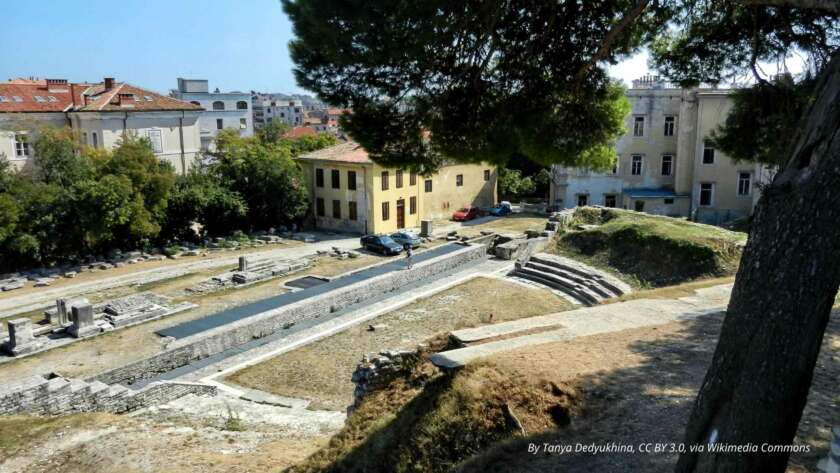
Its location at the foot of St. Nicholas Hill allows a view of the old town and the harbour from the upper tier, while its architecture – a mix of local limestone and marble –reflects the Roman influence in the region and the cultural importance of Pula at the time.
During the Middle Ages, the theatre was partly dismantled, with many of its stones reused in nearby constructions. After meticulous restoration work, it has regained its role as a lively cultural space. Today, it hosts concerts, plays, and festivals, keeping alive its ancient spirit as a meeting point for art and community — and undoubtedly one of the most rewarding things to do in Pula.
Brijuni National Park

For those searching for memorable things to do in Pula, a trip to Brijuni National Park is an experience that shouldn’t be missed. This stunning archipelago of 14 islands, just off the Istrian coast, is famous for its lush landscapes, archaeological remains, and rich cultural heritage. Designated a National Park in 1983, Brijuni preserves a unique mix of natural beauty and historical depth that continues to captivate every visitor.
The islands have Roman and medieval remains , such as villas, mosaics and tombs, reminding us that Brijuni was a place of retreat for Roman nobility and later for Venetian families. In the 20th century, it became the residence of Marshal Tito, and today it preserves historic buildings, a small safari park with exotic animals and botanical gardens that surprise with their biodiversity.
The park is ideal for those who are looking for relaxation: it can be explored by bicycle, tourist train or on foot, enjoying coves, viewpoints and paths surrounded by Mediterranean vegetation.
Still scrolling for ideas or ready to start your adventure? With the DareMapp app, you’ll make the most of every minute:
YOUR VISIT TO PULA ALREADY ORGANIZED AND AT YOUR PACE.
Verudela Point
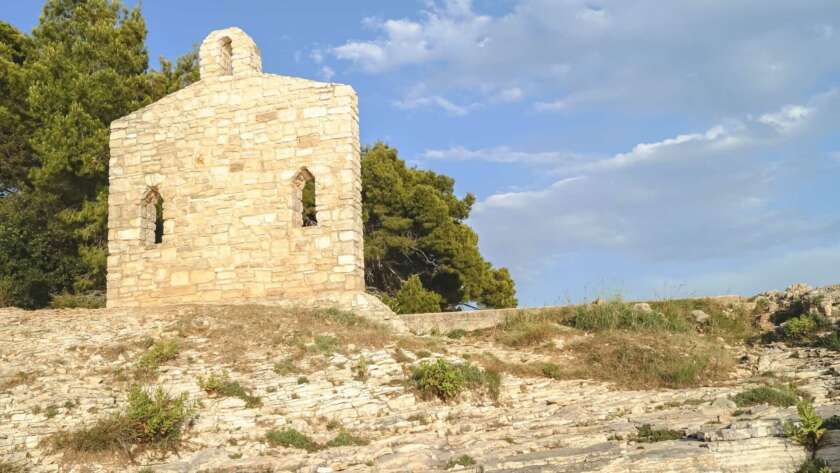
If you’re exploring the best things to do in Pula, Punta Verudela perfectly combines the city’s coastal beauty with its layered military history. Located about 4 kilometres south of the old town, this peninsula was strategically important throughout the centuries. Archaeological evidence points to Roman-era fortifications, later expanded during Venetian rule and reinforced in the 19th century under the Austro-Hungarian Empire, when coastal batteries were built to defend Pula’s naval base — one of the most significant in the Adriatic.
Its pine forests and Mediterranean scrubland are home to local birds and wildlife, while its coves, such as Verudela Beach and Ambrela, offer crystal-clear waters ideal for swimming, snorkelling and kayaking. Trails lead along cliffs and lookout points, while spectacular panoramic views of the town and harbour can be enjoyed.
The peninsula has restaurants, cafes and leisure areas, and sometimes hosts outdoor sporting and cultural activities, allowing you to enjoy the area with different rhythms and plans. The accessibility from the centre of what to see in Pula – by car, public transport or bicycle –makes it easy to visit without the need for complicated journeys.
Ambrela Beach
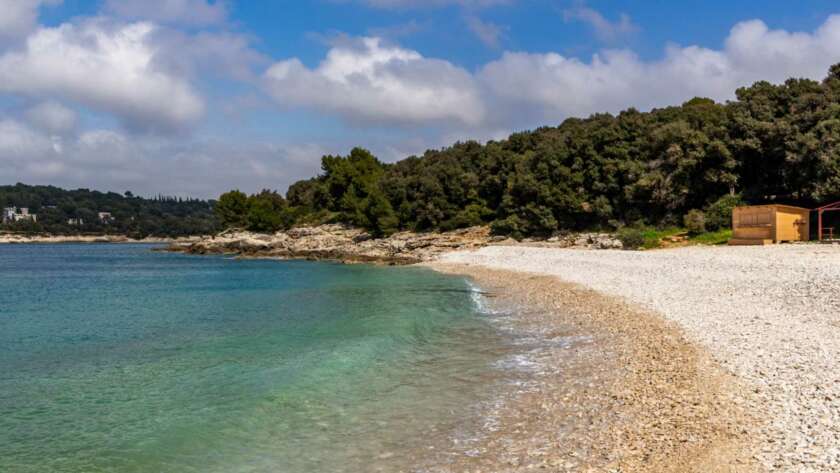
If you’re looking for a place to relax by the sea, Ambrela Beach is one of the most pleasant spots in Pula. Located on the Punta Verudela Peninsula, just south of the town centre, this beach of fine pebbles and golden sand is known for its clear, calm waters, ideal for swimming, snorkelling or simply enjoying the sun. Surrounded by pine trees and Mediterranean vegetation, it offers a natural, shaded environment that invites you to slow down and unwind.
Among the most enjoyable things to do in Pula, spending time at Ambrela Beach combines relaxation with a touch of history — the Verudela area once played a strategic defensive role during the Austro-Hungarian period. Today, the focus is on comfort and leisure: the beach offers showers, cafés, sun lounger rentals, and good access by car, bike or public transport, making it a favourite for both families and travellers.
Pula Central Market
Among the city’s most authentic experiences, a visit to the Central Market deserves a place on any list of essential things to do in Pula. Situated in the old town, this lively market has been a meeting point for locals and merchants for more than a century. It’s the perfect spot to explore fresh produce, from colourful fruit and vegetables to fish freshly caught in the Adriatic Sea.
But the market is much more than a place to shop — it’s a mirror of Pula’s history and culture. Its elegant Austro-Hungarian iron structure and surrounding stalls have witnessed the city’s evolution, from imperial times to modern-day Croatia. Walking through its aisles, you can feel the blend of Mediterranean flavours and Balkan influences, discovering how local gastronomy continues to shape the city’s identity.
Traveller’s tip: visit in the morning to see the activity at its peak and find the freshest produce. Take the opportunity to sample local specialities in the small cafes and stalls.
Consejos para viajar con tranquilidad.
Cuando todo está listo —vuelo, hotel, rutas— solo faltan dos cosas para viajar con total tranquilidad: una buena conexión a internet y un buen seguro de viaje.
✔ Lleva una eSIM internacional ya configurada en el móvil. Sin cambiar tarjetas, sin buscar wifi, sin roaming. Actívala antes de salir y navega con datos ilimitados desde el primer minuto, estés donde estés.
✔ Contrata un seguro de viaje, con asistencia médica 24/7, cobertura ante cancelaciones, robos y, sobre todo, que te adelante todos los gastos médicos sin que tú tengas que pagar, estés donde estés. Porque en un país nuevo, lo más importante es sentirte seguro. Además, DareMapp te ofrece un 5% de descuento directo.
Ambos servicios se contratan online, en menos de 5 minutos, sin papeleos.
No lo dejes para el último día.
👉 Activa tu eSIM de Holafly al mejor precio aquí.
👉 Contrata tu seguro de viaje con IATI y consigue un 5% de descuento.
Other things to do in Pula
If you’ve already explored the main attractions and want to keep uncovering new things to do in Pula, this selection of sites will take you deeper into its history, art, and everyday life. From the impressive Cathedral of the Assumption of the Virgin Mary to the charming statue of James Joyce, each stop reveals a different side of the city — its heritage, creativity, and the stories that continue to shape Pula’s character today.
Co-cathedral of Our Lady of the Sea
Another of the city’s hidden gems, and one of the most interesting things to do in Pula beyond its Roman heritage, is visiting the Co-cathedral of Our Lady of the Sea. Built between 1908 and 1910, during the final years of the Austro-Hungarian Empire, the church symbolised Pula’s close connection to the Imperial Navy, whose main base was located here.
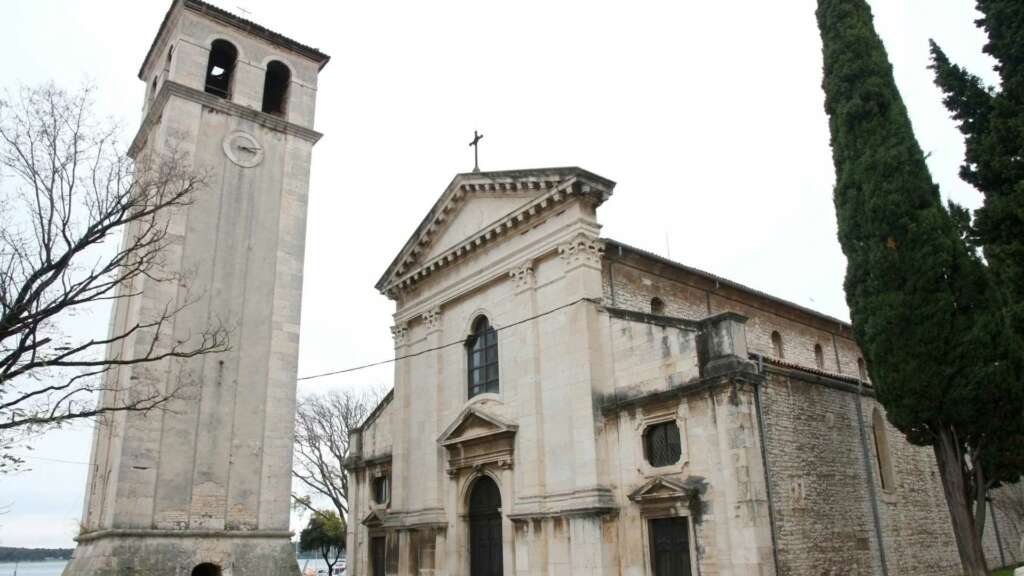
Designed in a neo-Romanesque style with elegant simplicity, it stands out for its maritime-inspired details and for the calm atmosphere that contrasts with the bustle of the port nearby. Inside, visitors can admire delicate stained-glass windows and subtle decorative motifs that evoke the sea, making it not only a place of worship but also a reflection of the city’s most recent historical chapter.
It represents the time when Pula was a strategic city on the Adriatic, a meeting point for cultures, languages and beliefs. Today it shares co-cathedral status with the Cathedral of the Assumption of the Virgin Mary, which reinforces its spiritual and cultural importance.
Chapel of Santa Maria Formosa
For those curious about the city’s quieter corners, the Chapel of Santa Maria Formosa is one of those discoveries that feels like stepping back in time. Tucked away near the square of the same name, this small chapel was built in the 15th century by a wealthy merchant family and reflects the elegant transition from Gothic to Renaissance architecture in Istria. Its proportions are simple yet refined, with carefully carved stone details that speak of the craftsmanship of the period. Visiting it is one of those things to do in Pula that often surprises travellers exploring the old town.
The interior preserves frescoes and reliefs depicting religious scenes, and the main altar shows details of carved wood and stone that allow us to imagine the work of the craftsmen of the time.
The chapel has been restored several times, preserving its original structure and the frescoes that have survived the centuries. For a long time it was the centre of local religious life, the scene of votive ceremonies and community meetings.
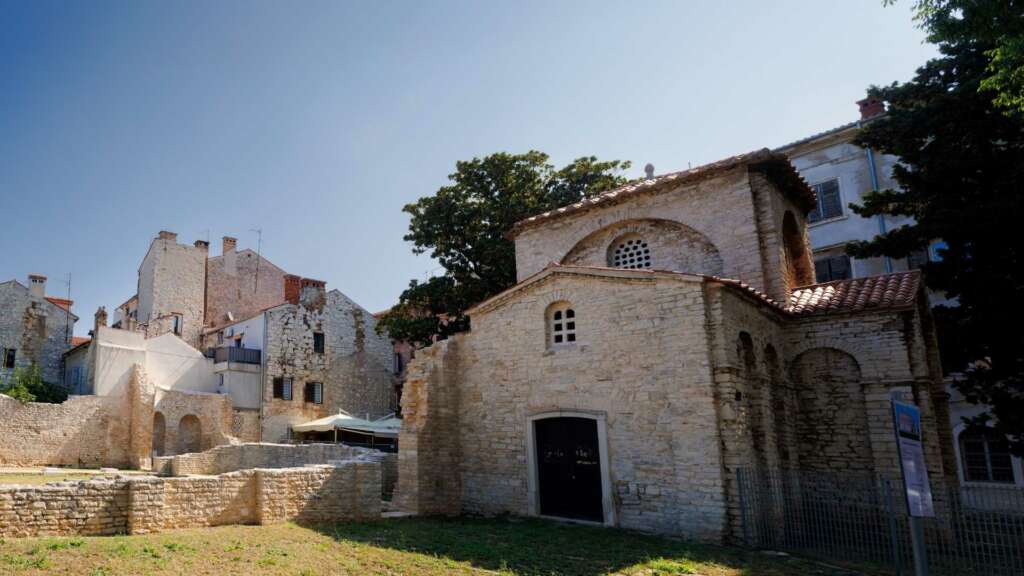
Today it also hosts cultural events and small concerts, maintaining its role as a meeting place for locals and visitors.
Roman mosaic of the “Punishment of Dirce”
The Roman Mosaic of “Dirce’s Punishment” is one of those discoveries that helps understand the depth of Pula’s Roman heritage. Housed in the Archaeological Museum of Istria, this detailed mosaic was once part of a luxurious Roman villa, probably belonging to a wealthy family of the city.
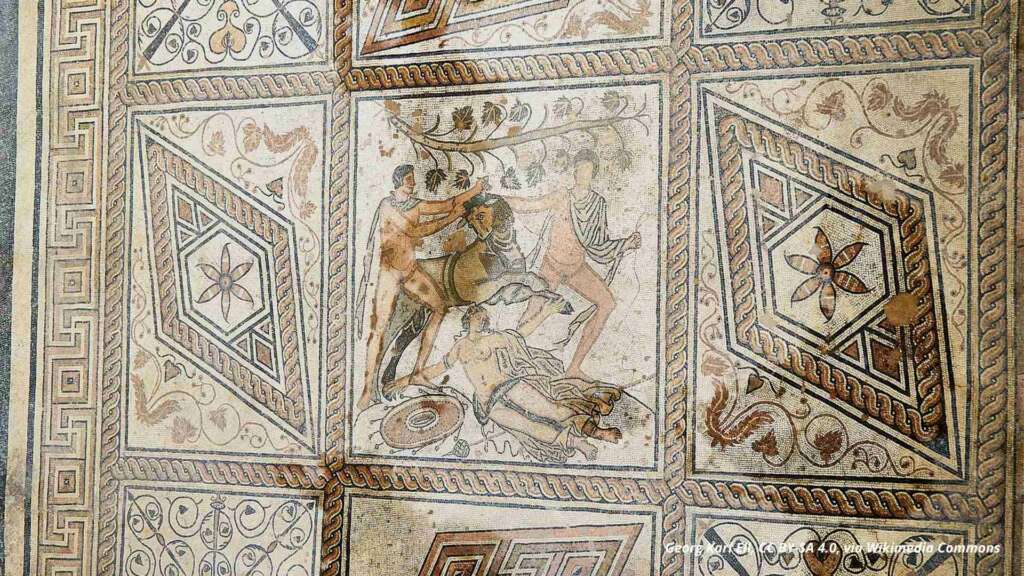
Depicting the mythological tale of Dirce’s punishment, it stands out for the precision of its opus tessellatum technique, where thousands of tiny stones form an intricate and expressive image.
Among the most captivating things to do in Pula, stopping to admire this mosaic offers more than just an artistic experience — it’s a window into the beliefs, values, and daily life of those who once lived here, where mythology and art were an integral part of the home.
💡 Traveller’s tip: take time to observe the details of the tesserae and the original colours that have been preserved. Take advantage of a visit to the Archaeological Museum to see other Roman artefacts and get a better understanding of what life was like in Pula more than 2,000 years ago.
Fort Bourguignon
Visiting Fort Bourguignon is one of the most interesting things to do in Pula for those who enjoy history. Built between 1861 and 1866 under the Austro-Hungarian Empire, this circular stone fort was part of a defensive network protecting the city’s naval base from land and sea attacks. Surrounded by pine trees, it still preserves the solid military design that once made Pula a key stronghold on the Adriatic.
The fort is characterised by limestone walls up to 4 metres thick, original cannons and underground passages. Its construction reflects Austro-Hungarian military engineering and adaptation to the terrain, with watchtowers and strategic emplacements controlling access to the port and town.
Today, Fort Bourguignon is also a place for leisurely strolls, with panoramic views of the harbour and the Pula coastline.
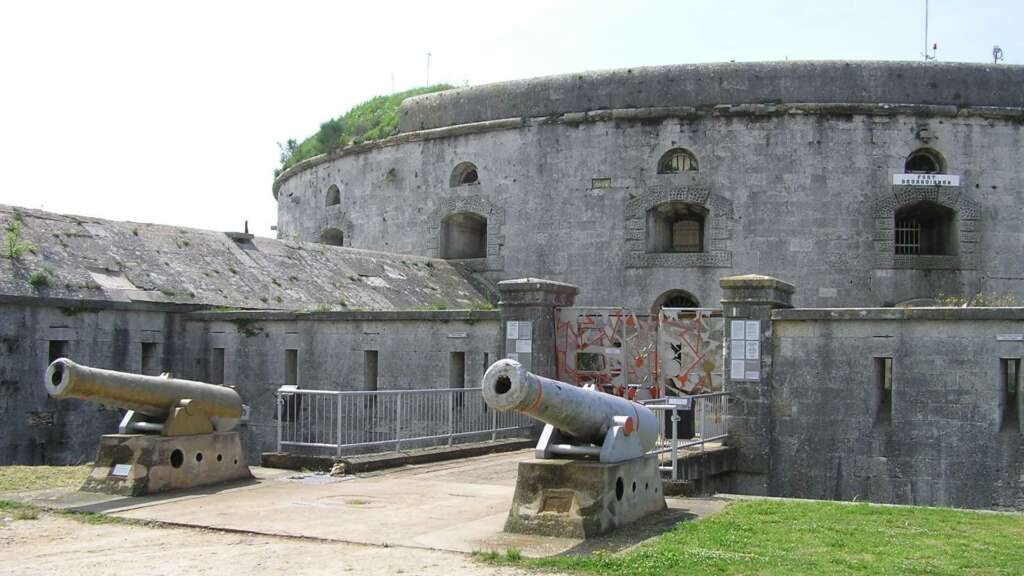
Statue of James Joyce
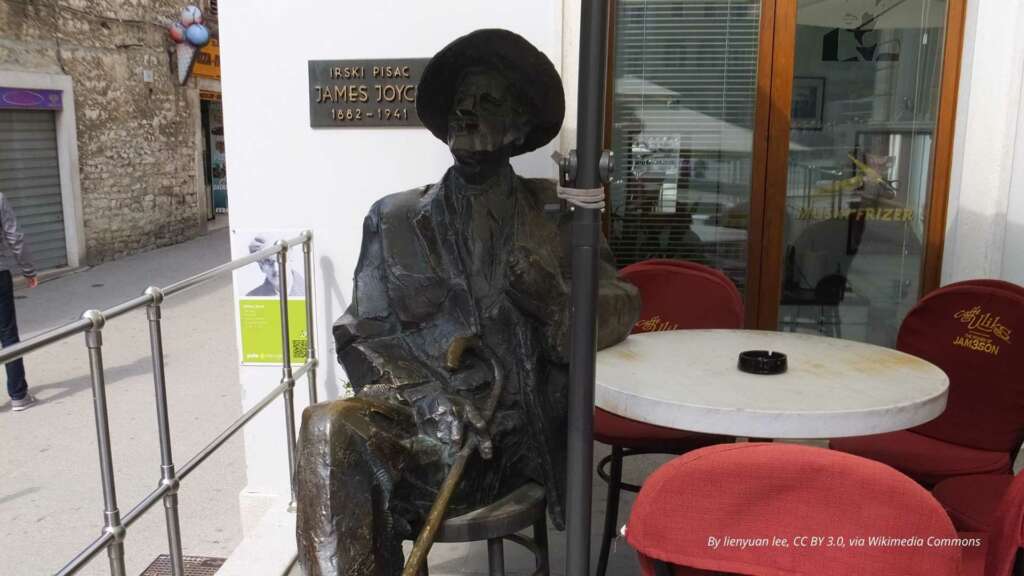
Among the more unexpected yet intriguing things to do in Pula, stopping by the James Joyce Statue offers a glimpse into the city’s modern cultural side. Located near the old town, this bronze sculpture pays tribute to the Irish writer, who lived in Pula briefly in 1904, when he taught English to naval officers.
The monument forms part of a project that aimed to bring contemporary art into historic spaces, creating a striking dialogue between the city’s Roman and medieval past and its more recent creative expressions. The figure of Joyce, casually seated as if observing life around him, invites visitors to pause and reflect on how literature and art continue to connect worlds.
Typical gastronomy in Pula: what to eat
Discovering what to eat in Pula means diving into the heart of Istrian cuisine, where the flavours of the sea and the land come together in a blend of tradition and creativity. From Istarski fuži with truffles to freshly grilled seafood, every dish tells a story about the region’s character, inviting you to experience its culture through flavours, aromas, and recipes passed down through generations.
Istarski fuži with truffles
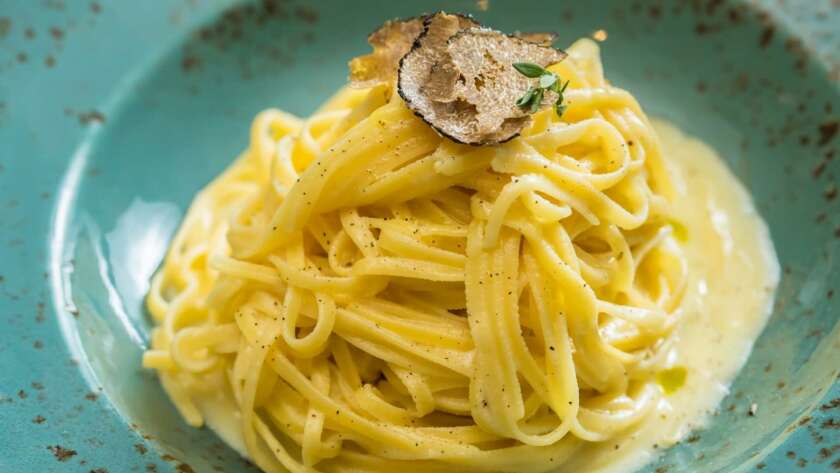
Among the most delicious things to do in Pula, tasting Istarski fuži with truffle is an experience not to be missed. Fuži are a traditional Istrian pasta, handmade from wheat flour and eggs, rolled into small tubes that perfectly hold the rich truffle sauce. This combination captures the essence of local cuisine — simple ingredients transformed into something deeply flavourful and unmistakably tied to the region’s identity.
The star accompaniment is Istrian truffles , finely grated over the pasta just before serving. The classic recipe usually includes butter, olive oil and a touch of grated local cheese, which enhance the intense aroma of the truffle. Some restaurants add a light layer of cream to soften the flavour and give it a creamier texture.
💡 Traveller’s tip: look for restaurants that make fresh pasta by hand and offer truffle-fuzi with freshly grated truffle. Serving it hot and freshly prepared maximises its flavour and aroma.
Brudet (or Brodetto)
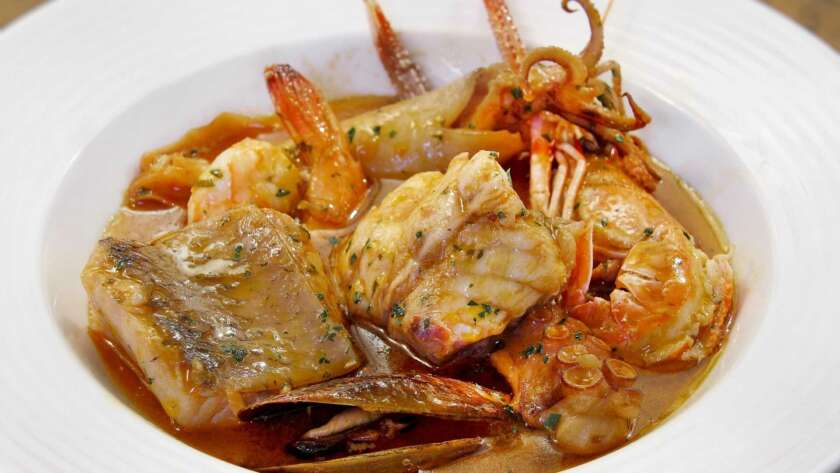
Brudet is one of those dishes that truly captures the spirit of Pula’s coastal cuisine. This hearty fish stew, made with a mix of Adriatic fish, tomato, onion, garlic, white wine and Mediterranean herbs, is slow-cooked to let the flavours deepen while keeping the fish tender.
Among the most authentic things to do in Pula, trying a bowl of Brudet connects visitors with the city’s fishing heritage — a recipe born from fishermen who used the day’s catch and local ingredients.
Traditionally served with creamy polenta or homemade bread, it’s a comforting, flavour-packed reflection of Pula’s culinary soul.
Pljukanci with meat ragu

A plate of pljukanci with meat ragù is one of the most traditional ways to taste Istrian cooking. These hand-rolled, slightly twisted pieces of pasta are perfect for catching the rich, slow-cooked sauce made with beef or pork, tomato, onion, garlic and local herbs.
Among the most satisfying things to do in Pula, trying this dish reveals how simple ingredients become something deeply comforting. Often topped with grated local cheese, it’s a rustic, flavourful recipe that speaks to the heart of the region’s home-style cuisine.
Jota

Among the most traditional flavours to try, Jota stands out as a dish that tells part of Pula’s story through its ingredients. This hearty Istrian stew blends cabbage or sauerkraut, potatoes, beans, and sometimes pork or bacon, all simmered slowly to create a rich, comforting meal.
The secret lies in the fermented cabbage, which gives it that slightly sour depth so characteristic of Istrian mountain cuisine.
💡 Traveller’s tip: When exploring the many things to do in Pula, tasting Jota in a small trattoria or family-run restaurant adds an authentic local touch — a simple, warming way to understand the region’s culture through its food.
Grilled seafood

Among the must-try local experiences, grilled seafood is a highlight that captures the essence of Pula’s coastal life.
This dish showcases the freshness and simplicity of Adriatic cuisine, where flavour depends entirely on the quality of the catch. Typically prepared with cuttlefish, squid, prawns, mussels, or octopus, it’s marinated in olive oil, garlic, lemon, and parsley, then grilled until perfectly tender inside and lightly charred outside.
When exploring the many things to do in Pula, tasting this dish is a true reflection of the city’s fishing heritage, where honest, fresh ingredients speak louder than complexity.
Fritule

No visit to Pula would be complete without trying Fritule, the small golden fritters that bring a sweet finish to any day of exploring. These bite-sized treats, made from flour, eggs, sugar, citrus zest, rum, and sultanas, are fried until crisp on the outside and soft inside, then dusted with icing sugar.
They’re a staple at celebrations and local markets, filling the air with their warm, inviting aroma. Among the most delightful things to do in Pula, tasting Fritule connects travellers with the region’s Venetian and Dalmatian influences, a blend of traditions that perfectly reflects the city’s diverse cultural heritage. Served hot, they pair wonderfully with coffee or a glass of local sweet wine.
🤤 Mouth-watering, right? Us too. That’s why we’ve made it simple: the best food stops in Pula, ready so you don’t waste a single minute.
Say goodbye 👋🏻 to endless scrolling and start savouring Pula for real.
Museums to visit in Pula
Among the many things to do in Pula, visiting its museums is essential to understand the city’s rich history and unique character. Each one reveals a different side of its identity — from ancient artefacts to maritime heritage — offering a journey through centuries of culture and creativity that still shapes the city today.
Archaeological Museum of Istria
Among the most interesting things to do in Pula, a visit to the Archaeological Museum of Istria is a must for anyone wanting to understand the region’s deep roots. Founded in 1902, the museum houses an impressive collection of artefacts spanning from prehistoric times to the Middle Ages, gathered from across the Istrian peninsula.
Located beside the Roman Theatre, in what was once a Franciscan monastery, it displays ceramics, sculptures, inscriptions, and mosaics unearthed at key sites such as the Roman Amphitheatre. The highlight is its Roman collection, which illustrates Pula’s significance as an imperial colony and a thriving Adriatic trading hub during the height of the Roman Empire.
Istrian Historical and Naval Museum
The Istrian Historical and Naval Museum is one of those places that combine culture, history, and unforgettable views over the city. Housed in the Kastel, a 17th-century Venetian fortress built on the remains of the ancient Roman acropolis, it once served to defend the town and its harbour.
Inside, visitors can explore the region’s story from the Middle Ages to the 20th century, with rooms dedicated to its maritime and military past. Among the most enriching things to do in Pula, discovering this museum means uncovering maps, uniforms, weapons, and naval artefacts that illustrate the city’s rise as an Austro-Hungarian stronghold and a key naval centre in the Adriatic.
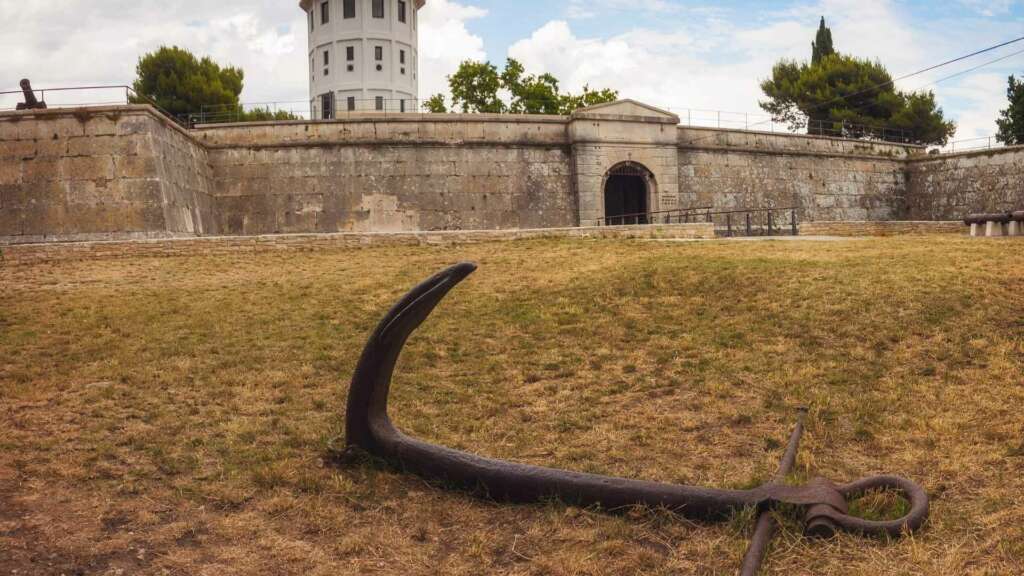
Tip: climb up to the bastion’s terrace at sunset — the view is unforgettable. It’s one of the most photogenic spots in the city and definitely among the most memorable things to do in Pula.
House of Istrian Olive Oil (Museum Olei Histriae)
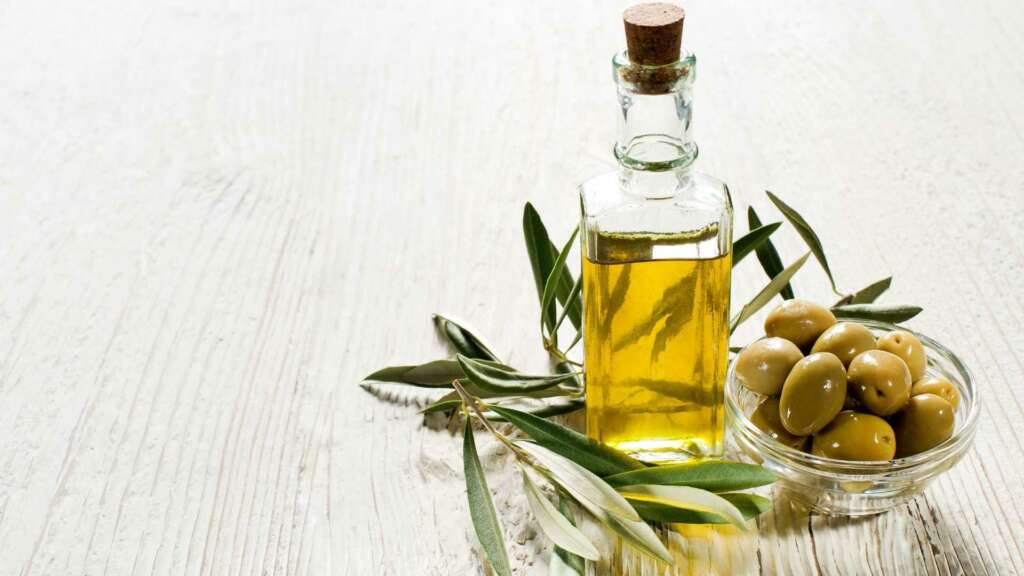
Among the most authentic things to do in Pula, a visit to the House of Istrian Olive Oil is a must for anyone interested in gastronomy and tradition. This museum, dedicated to one of Istria’s most emblematic products, traces the history of olive oil from Roman times to today’s modern production.
Interactive displays and guided tastings reveal how the region’s climate and soil have helped make Istrian olive oil among the best in the world. Visitors can learn to recognise different varieties, aromas, and qualities, understanding the deep connection between olive cultivation and local life.
Among the most flavourful things to do in Pula, tasting award-winning oils from local producers is an experience that captures the true Mediterranean essence of the city.
👁️ Still looking for information about Split? Everything you are looking for is in the DareMapp app.
Plans and activities to do in Pula
Beyond its monuments and ancient sites, Pula also offers experiences that bring the city to life in a different way. From light shows that illuminate the harbour to outdoor adventures and family-friendly activities, there’s always something happening here, day or night. Among the most entertaining things to do in Pula, these plans let you enjoy the city at your own rhythm and discover its modern, creative side.
Harbour lighting and “Lighting Giants”

One of the most original things to do in Pula is watching the Lighting Giants, a night-time spectacle that turns the harbour into an open-air artwork. Every evening, the cranes of the former Uljanik shipyard — a symbol of the city’s industrial past — light up with synchronised coloured LED displays, creating reflections that dance across the sea.
Designed by Pula-born lighting artist Dean Skira, the project pays tribute to the shipyard’s workers, whose craft defined the city’s economy and identity for over a century.
Visible from several points along the promenade, this free show is among the most impressive things to do in Pula at night, a perfect way to enjoy the local atmosphere and end the day with something truly memorable.
Pula Aquarium (Fort Verudela)
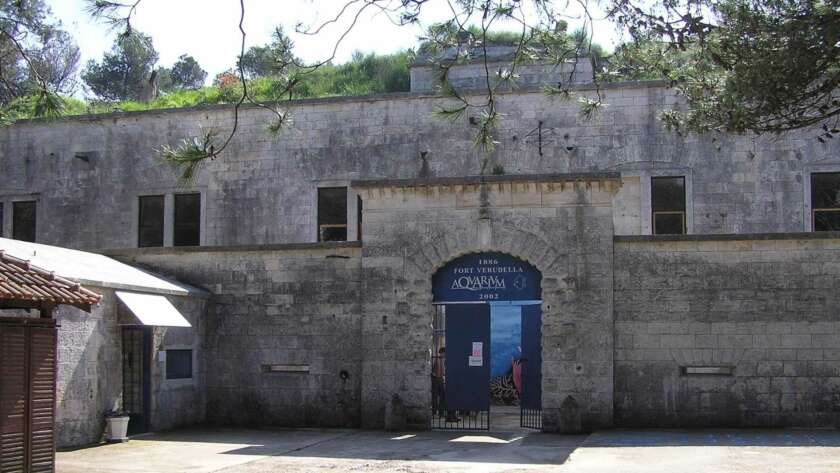
Among the most enjoyable things to do in Pula, visiting the Pula Aquarium is a perfect plan for families and anyone fascinated by the sea. Set inside Fort Verudela, a coastal fortress built in the late 19th century by the Austro-Hungarian Empire, it offers a unique mix of military history and marine exploration.
The aquarium is home to more than 100 species of fish and sea creatures from the Adriatic and beyond — from octopuses and seahorses to jellyfish and colourful reef species — along with exhibits that explain local marine ecosystems. It’s an engaging way to learn about the region’s biodiversity and Pula’s historic link to fishing and maritime trade.
💡 Tip: set aside at least an hour to explore every room, and don’t miss the interactive tanks, where you can get an up-close look at the animals’ fascinating behaviour.
Istrian wine cellar tour
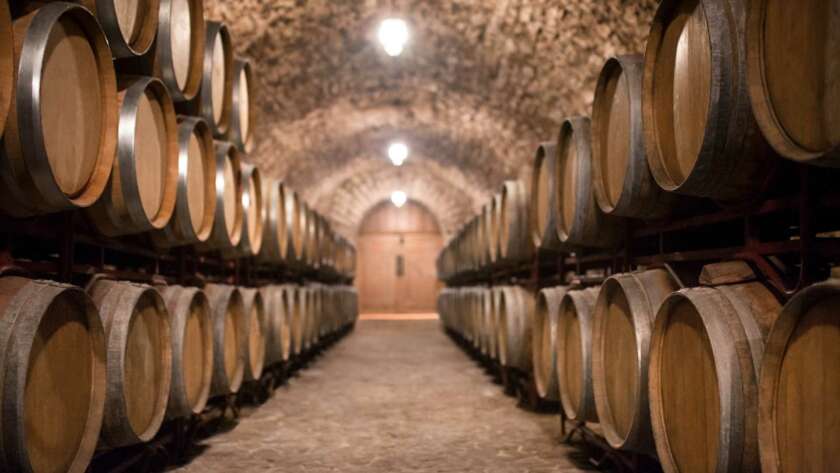
If you’re wondering what to see in Pula, a visit to the Istrian wine cellars is an experience about history, landscape and gastronomy. The region is famous for its Malvazija and Teran wines, grown in vineyards that sometimes date back centuries.
During the tour you can tour the vineyards, learn about traditional and modern wine production and, most attractively, participate in guided tastings of local wines and olive oil. It’s a delightful way to connect with the culture and economy of the region.
Boat trip along the coast and nearby beaches
Taking a boat trip along Pula’s coast is one of the best ways to see the city from a new angle. Departing from the harbour, these excursions explore hidden coves, secluded beaches, and nearby islands only reachable by sea.
It’s an ideal mix of relaxation and adventure, with time to swim, snorkel, or simply enjoy the views of the Adriatic. Among the most memorable things to do in Pula, this experience often includes fascinating stories about the city’s maritime past, blending natural beauty with the history that has long shaped life by the sea.
Nearby excursions from Pula
If you’re looking to go beyond the city, some of the most rewarding things to do in Pula include exploring its surroundings. From nature parks and coastal villages to picturesque Istrian towns nestled inland, these day trips reveal the region’s diverse landscapes, rich history, and vibrant culture — all within easy reach and perfect for a full-day adventure.
Rovinj
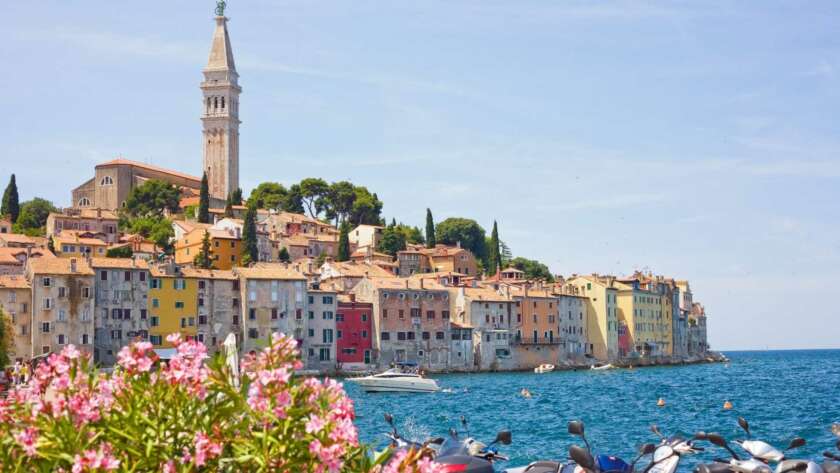
A day trip to Rovinj is one of the most picturesque things to do in Pula. This coastal gem on the Istrian peninsula enchants visitors with its medieval old town, where cobbled streets and colourful houses climb towards the Church of St. Euphemia, the symbol of the city’s skyline.
Rovinj’s atmosphere still reflects its long Venetian past, visible in its architecture, lively squares, and scenic harbour that keep its maritime soul alive. Wandering through its narrow streets, you’ll find art galleries, artisan workshops, and cosy cafés overlooking the Adriatic — the perfect blend of history and seaside charm.
Poreč
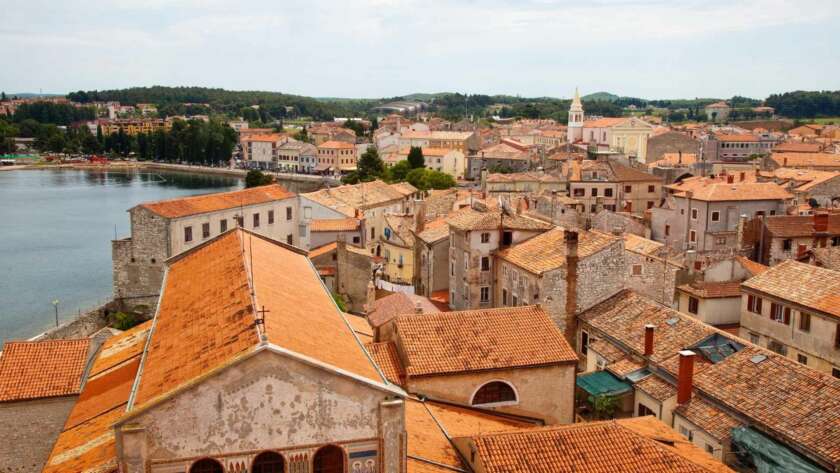
A visit to Poreč is among the most fascinating things to do in Pula, especially for those who enjoy a mix of history and seaside atmosphere. The town’s old centre, structured around the ancient Roman decumanus, still preserves streets, palaces, and remains from its earliest days, all leading to its greatest treasure — the Euphrasian Basilica, a UNESCO World Heritage Site.
Poreč embodies the blend of cultures that has defined Istria for centuries, from Roman and Byzantine influences to Venetian heritage, offering a journey that seamlessly connects art, architecture, and coastal life.
Motovun and the Istrian hinterland
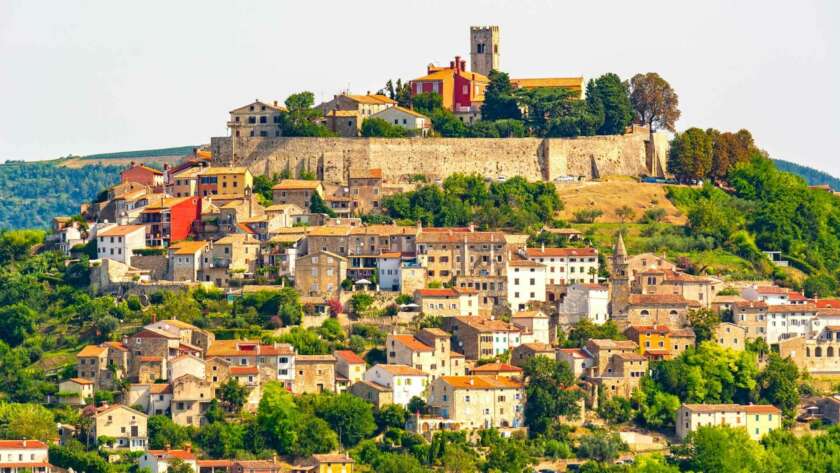
To add a different touch to your visit, one of the most enriching things to do in Pula is to explore Motovun and the Istrian hinterland. This inland region reveals a new side of Istria, with rolling hills, vineyards, and medieval villages that preserve age-old traditions.
he hilltop town of Motovun, crowned by its ancient fortress, offers breathtaking panoramic views of the valley and is renowned for the prized Istrian black truffle, a true local delicacy. Travelling through the hinterland, you’ll find craft workshops, wine routes, and charming small towns that showcase the authentic culture and natural beauty of Istria beyond its coastline.
💡 Tip: combine a visit to Motovun with a truffle or local wine tasting and a stroll through the village.
Local legends and curiosities of Pula
Exploring the many things to do in Pula also means uncovering the stories and secrets that give the city its soul. Here you’ll come across local legends, curious facts, and centuries-old traditions that reveal Pula’s distinctive character — connecting its ancient past with the experiences of today’s travellers.
The legend of the Pula Amphitheatre
One of the most enchanting stories linked to the city tells that the Roman Amphitheatre was built by fairies who worked through the night. According to local legend, these magical beings carried stones from Mount Učka and arranged them in a perfect circle to create a city called Divić-grad, a name derived from the Slavic word diva, meaning “miracle.” Among the most curious things to do in Pula, discovering this legend offers a glimpse into how locals once explained the creation of such an extraordinary monument — a tale that blends admiration, imagination, and cultural heritage.
The tragic history of the Augustan Temple

At the heart of the city, the Temple of Augustus stands as both a masterpiece of Roman architecture and a symbol of the spiritual life that once flourished in Pula. According to tradition, the figures carved on its capitals acted as silent protectors, guarding the inhabitants from disease and misfortune.
Among the most intriguing things to do in Pula, visiting this temple offers the chance to sense the atmosphere of rituals and offerings that once filled the space — a lingering energy from nearly two thousand years ago.
Take time to look closely at the sculptural details and Latin inscriptions; each stone preserves a small but powerful piece of the city’s enduring history.
The mystery of the Sergios Arch
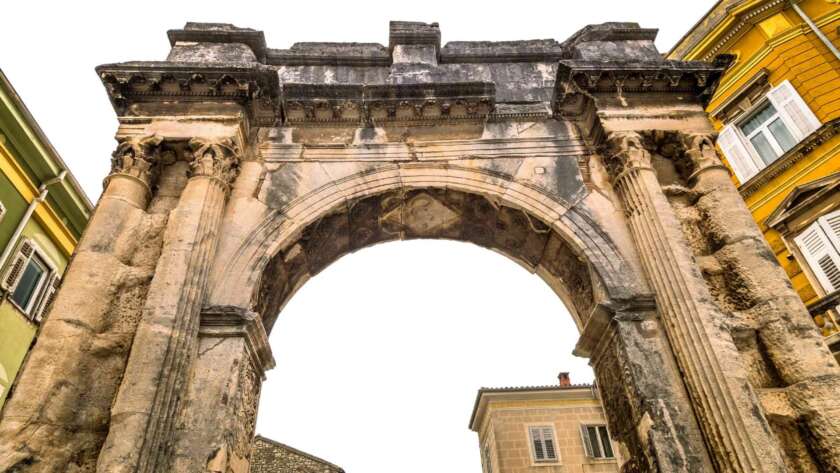
The Arch of the Sergii, one of the most ancient monuments in the city, was built as a testament to family power and protection. Legend suggests that the symbols carved into its reliefs could only be understood by those initiated into Roman traditions, holding hidden messages about alliances, wars, and the city’s secrets.
Among the most fascinating things to do in Pula, standing before the arch feels like reading a message that has travelled through centuries — its architecture and iconography still speak of prestige, strategy, and the enduring civic pride of ancient Pula.
Still looking for information about Pula?
Everything you are looking for is here.
With the DareMapp app, explore Pula like never before: interactive tours, tips and routes on your phone.
The legend of the Argonauts and the origins of Pula
One of the most fascinating legends about Pula’s origins takes us back to Greek mythology and the famous tale of the Argonauts — a band of heroes led by Jason, who set out to find the Golden Fleece, a symbol of power and divine favour. According to ancient legend, after stealing the fleece from the distant land of Colchis, Jason and his companions fled across the Adriatic Sea, pursued by King Aeëtes, the ruler they had betrayed. During their escape, one of the Argonauts was killed, and the fugitives, unable to return home, decided to settle where they landed — on the Istrian coast, where the city of Pula now stands.
The story gave rise to the belief that Pula was born from exile and adventure, blending myth with geography. For centuries, locals have passed down this tale as a poetic explanation of the city’s beginnings — a legend that links its Roman stones and Adriatic waves to the ancient world of heroes and gods.
Practical advice and top tips for travelling to Pula
Planning your trip is easy, but knowing a few tips can make it even better. Here are some practical suggestions — and a few insider ones — to help you make the most of your visit and enjoy all the best things to do in Pula.
Getting to and around Pula
Pula has a small but efficient international airport with flights from several European cities. You can also get there by train or bus from Rijeka, Zagreb or Ljubljana.
Once in the city, walking is the best way to explore the old town, its squares and Roman monuments. For longer distances, city buses work well and there are options for 1, 24 or 72-hour tickets.
⭐️ Top tip: renting a bike or scooter is a practical and fun way to explore the coast and reach beaches or scenic spots.
Payment and prices
Payment in Pula is made in euros (EUR), Croatia’s official currency since 2023. Most restaurants, hotels, and shops accept credit and debit cards, but it’s still a good idea to carry some cash for small purchases, local markets, or places that don’t accept cards.
Prices are moderate: an average meal in a local restaurant is around €15-20 and a beer around €3-4.
⭐️ Top tip: Look for the ‘menu dana’ (daily set menus) in family restaurants; they’re cheap and offer typical home-cooked food.
Plugs and electricity
C and F type plugs are used in Croatia, with 230V current, as in most of mainland Europe. If you’re coming from the UK, USA or another country with different plugs, you’ll need an adapter.
⭐️ Top tip: take a compact power strip if you’re travelling with several devices; in small hotels, sockets may be limited.
Entrance fees and museums
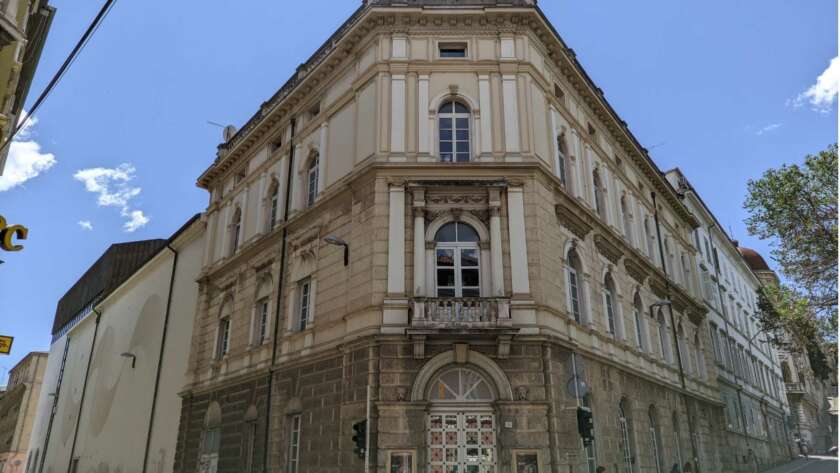
Many museums in Pula, such as the Archaeological Museum of Istria or the Historical and Naval Museum, offer discounts for students and groups. To save time, it is advisable to book tickets online, especially for the Roman Amphitheatre or the Fort Verudela Aquarium, which tend to be very busy in high season.
⭐️ Top tip: buy the Pula Card (if available during your visit); it includes discounts on museums, transport and attractions, making it easy to find out what to see in Pula.
We hope this guide to the must-see sights in Pula will help you discover the essence of this city. But if you want to live it to the fullest, don’t miss the DareMapp app!
With it you’ll have everything in just one app:
✅ Gamified routes through the Roman Amphitheatre and the old town of Pula, discovering stories, legends and corners that few travellers know about.
✅ Local recommendations: authentic Istrian taverns (konobas), quiet beaches and seafront bars overlooking the Adriatic.
✅ Nearby excursions to Brijuni National Park, Rovinj or the Istrian hinterland, to explore the region at your own pace.
different plans in Pula at night: shows in the amphitheatre, strolls along the illuminated harbour or a drink with the “Lighting Giants”.
💫 You’re just a click away from swapping reading for adventure.
🗺️ Your route through Pula, with Daremapp
📍More than 30 points of interest
🚀 An organised route to make the most of your time
💡Recommendations, excursions & unique experiences
❓ Questions, quizzes and more than 2 hours of narrated content
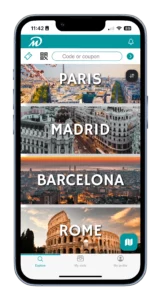
Click here to discover all our destinations.
Remember, with DareMapp you can explore countless guided tours in a fun and interactive way.
What better way to travel and discover a city than learning in a fun way? Visit our blog to discover a lot of tips about tourism.
Visit our social networks and discover what to see in hundreds of cities.


